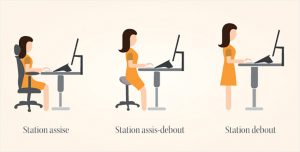Proper sitting posture at computer – Do you work in front of the computer every day? Are you often tired at the end of the day and sometimes have back pain? Wondering why, why didn’t you make any physical effort?
Look no further, we have the answer.
It is the time spent sitting that gives you this feeling of tiredness, even pain.
This is due to bad habits and feelings of comfort that make us assume the wrong positions in front of our computer keyboards. And this is not good for your health!
What is the Proper sitting posture at computer
The engineeringsadvice.com team did some research to find out what was the right posture to adopt to avoid fatigue and pain.
Whether you are used to working standing, sitting in a chair, on an armchair or on a ball, the tips will be the same for your position.
Proper sitting posture at computer: Body Posture

Proper sitting posture at computer: The Head
The head should be kept above the shoulders while standing upright and leaning against the chair.
The top of the screen should be at eye level. A screen that is too low or too high will encourage you to pull the back of the neck. Your gaze should fall slightly downwards, without tilting your neck.
It is preferable that the screen is placed between 50 and 70 cm from the eyes.
If it’s sunny outside, remember to close the curtains or blinds to limit the annoying light on the screen as much as possible. This will help keep your eyes from straining too much.
Proper sitting posture at computer: The Bust
Your back should rest against the back of the chair, which will allow you to have a straight spine. You don’t have to have a rounded back. If necessary, put a pillow behind your back. The body should be close to your desk.
The shoulders are relaxed and the arms close to the ribs, perpendicular to the body. They must form a right angle. Use the armrests of your chair to get the right arm position.
Wrists should be flat, but not resting on the desk. Use a palm rest if you have trouble keeping them in a vacuum.
The ideal distance for your keyboard is 15 cm from the edge of your desk, this will facilitate the correct positioning of your arms.
If your computer is sitting on your lap or on a coffee table, consider lifting it using a stand. So you won’t strain your spine.
Proper sitting posture at computer: Lower Body
Sit well in the seat so that your back is supported.
Your feet should be flat on the ground. Feel free to use a footrest for this.
The knees should be at the same height as the hips and form a right angle.
Do you need a new laptop screen? Find what you need here!
Get Good Habits

Despite an ideal posture thanks to the tips above, here are some other good habits to take.
Before starting work
When you arrive at your desk in the morning, do these little exercises that will prepare your muscles for prolonged inactivity.
And yes, like a competitive sport, working seated deserves a warm-up!
During your working hours
It is advisable to change positions regularly so as not to remain still for too long.
To avoid headaches or other ailments, take short breaks every 30 minutes!
When you are in a job where there is a sedentary lifestyle, it is recommended to practice regular sporting activity once or twice a week.
During the breaks
Your pauses should only be used for looking at the phone or for standing still. On the contrary, this rest must be active to allow for an improvement in blood circulation.
Take this break for yourself:
- stretch your legs while walking around your premises or take the opportunity to visit a colleague who is in another room.
- relax your joints by doing small exercises like twisting your wrists, neck, shoulders or knees.
- stretch the muscles.
It is important to keep your eyes off any screens during this break. You can close them for a few seconds or massage them.
In case of pain
In the evening when you come home, if you feel any pain in your muscles or joints, we recommend this.
For muscle pain:
- massage the muscle with a suitable cream or gel. Massage needs to warm up the muscles to relieve pain.
- or simply apply a hot object such as a hot water bottle to the muscle.
For joint pain:
- apply a heat source, such as a hot water bottle, to the affected joints. That will reduce the pain
- in case of inflammation, it is better to apply ice to the sore spot.
What are the risks of poor posture?
According to a study by experts for the Washington Post, sitting for an average of 8 hours a day causes pain “from the head to the feet”. We talk about fairly classic ailments but also about more worrying diseases:
- neck pain and back pain which can lead to diseases such as herniated disc or sciatica.
- cardiovascular risks that can impede the blood supply to the muscles due to the compression of the blood vessels. Which can cause varicose veins.
- headaches, eye disorders and sleep disturbances.
- carpal tunnel syndrome.
It’s true that looking at this list is terrifying! That is why it is critical to alert your body to all of the potential dangers that may lie ahead.
Some businesses have found an alternative to providing adjustable desks to their employees in order to alleviate concerns about poor posture. Desks that may be utilized standing or seated. Some even include treadmills so that employees may stay active while working.


